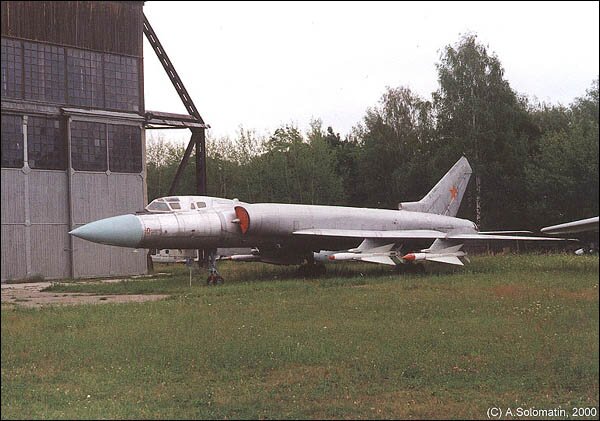
Tu-128 (NATO: Fiddler - «Fiddler (street)") - a Soviet
double loitering long-range interceptor.
In 1955, the Soviet air defense interceptors needed for long-range defense vast territory of the Soviet Union. Due to the huge air space, even with more advanced economies, it would be impossible to provide full ground-air defense. In order to provide the necessary range, the ability to be a powerful radar and missile air-to-air, Tupolev developed an aircraft similar to the Tu-105 (Tu-22). Designed Tu-102 first flew in 1959 and became known as the Tu-28P, serial production began in 1963. He was replaced by the final Tu-128.
Loitering interceptor Tu-128 is based on the failure supersonic bomber Tu-98, which had extensive low-lying swept wings, bearing the main landing gear in fixed wing compartments, and low-lying stabilizers. Two turbojet engine AL-7F-2 were located in the fuselage. In contrast, the Tu-22, he did not have an internal weapons bay. Armament was fixed on the wing pylons and the fuselage used for the huge fuel tanks. Tu-28P had two separated cabins for two people, placed one after the other.
As Western experts have suggested the Tu-102 was a big built-in radar, but the bulge on the underside of the aircraft is actually included test equipment. At the Tu-28P had a great nose cone for teploradiolokatsionnoy missile weapons control system "Cyclone-100" with a radius of detection of approximately 50 kilometers and capture targets 40 kilometers away. Thanks to the long-range detection radar was not required precise conclusion on the target aircraft with ground-based guidance system, it could target and catch yourself. In autonomous operations required only a few data on the status of air targets. This allowed us to use it in areas where there were no computer-aided guidance. Later, he often flew in the group with AWACS aircraft Tu-126. As a pure interceptor, the Tu-28P was almost no electronic warfare systems and protective equipment and warning system for radar illumination, like a smaller Sukhoi interceptors.
Tu-28 was a pure interceptor with high wing loading, simple equipment and poor visibility, high weight, maneuverability and modest. The aircraft was designed to intercept bombers of NATO, such as the B-52, but not for air combat with smaller aircraft.
Tu-28 weapons were four missiles air-KB Binosvata R-4/K-80. The usual configuration of the weapons were two F-4F with a semi-active radar-guided on the outer pylons and two P-4T infrared-guided internal. Tu-128 complex was renovated in the 70s and adopted for use with missiles R-and R-4PM 4TM.
December 12, 1963 order of the Minister of Defence 00 134 number assigned name for the aircraft missile system to intercept (ARKP) as the Tu-128S-4, comprising:
Tu-128 - the plane
P-and R-4P 4T - missiles "air-to-air"
Radar RP-C "Whirlwind"
Release of the Tu-128 ended in 1970. A total of 188 aircraft were built. Also in 1971, was released 10 training aircraft, and 4 have been converted from a fighter named TU-128UT with additional front cabin on the ground radar. Advanced Projects Design Bureau named Tu-138 and Tu-148 development is not received.
In 1955, the Soviet air defense interceptors needed for long-range defense vast territory of the Soviet Union. Due to the huge air space, even with more advanced economies, it would be impossible to provide full ground-air defense. In order to provide the necessary range, the ability to be a powerful radar and missile air-to-air, Tupolev developed an aircraft similar to the Tu-105 (Tu-22). Designed Tu-102 first flew in 1959 and became known as the Tu-28P, serial production began in 1963. He was replaced by the final Tu-128.
Loitering interceptor Tu-128 is based on the failure supersonic bomber Tu-98, which had extensive low-lying swept wings, bearing the main landing gear in fixed wing compartments, and low-lying stabilizers. Two turbojet engine AL-7F-2 were located in the fuselage. In contrast, the Tu-22, he did not have an internal weapons bay. Armament was fixed on the wing pylons and the fuselage used for the huge fuel tanks. Tu-28P had two separated cabins for two people, placed one after the other.
As Western experts have suggested the Tu-102 was a big built-in radar, but the bulge on the underside of the aircraft is actually included test equipment. At the Tu-28P had a great nose cone for teploradiolokatsionnoy missile weapons control system "Cyclone-100" with a radius of detection of approximately 50 kilometers and capture targets 40 kilometers away. Thanks to the long-range detection radar was not required precise conclusion on the target aircraft with ground-based guidance system, it could target and catch yourself. In autonomous operations required only a few data on the status of air targets. This allowed us to use it in areas where there were no computer-aided guidance. Later, he often flew in the group with AWACS aircraft Tu-126. As a pure interceptor, the Tu-28P was almost no electronic warfare systems and protective equipment and warning system for radar illumination, like a smaller Sukhoi interceptors.
Tu-28 was a pure interceptor with high wing loading, simple equipment and poor visibility, high weight, maneuverability and modest. The aircraft was designed to intercept bombers of NATO, such as the B-52, but not for air combat with smaller aircraft.
Tu-28 weapons were four missiles air-KB Binosvata R-4/K-80. The usual configuration of the weapons were two F-4F with a semi-active radar-guided on the outer pylons and two P-4T infrared-guided internal. Tu-128 complex was renovated in the 70s and adopted for use with missiles R-and R-4PM 4TM.
December 12, 1963 order of the Minister of Defence 00 134 number assigned name for the aircraft missile system to intercept (ARKP) as the Tu-128S-4, comprising:
Tu-128 - the plane
P-and R-4P 4T - missiles "air-to-air"
Radar RP-C "Whirlwind"
Release of the Tu-128 ended in 1970. A total of 188 aircraft were built. Also in 1971, was released 10 training aircraft, and 4 have been converted from a fighter named TU-128UT with additional front cabin on the ground radar. Advanced Projects Design Bureau named Tu-138 and Tu-148 development is not received.

No comments:
Post a Comment